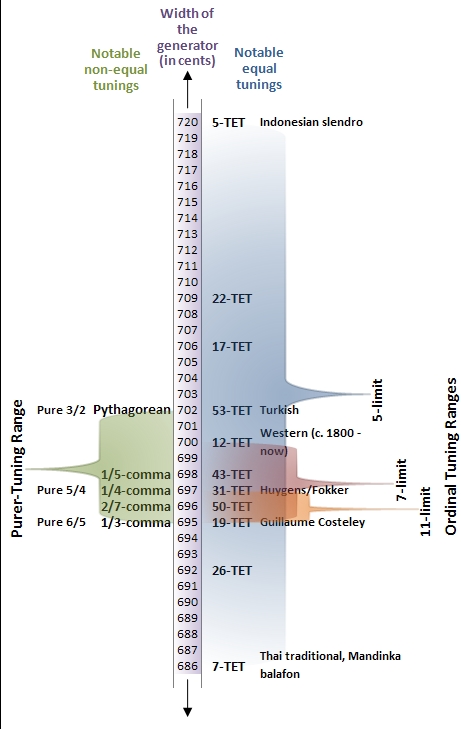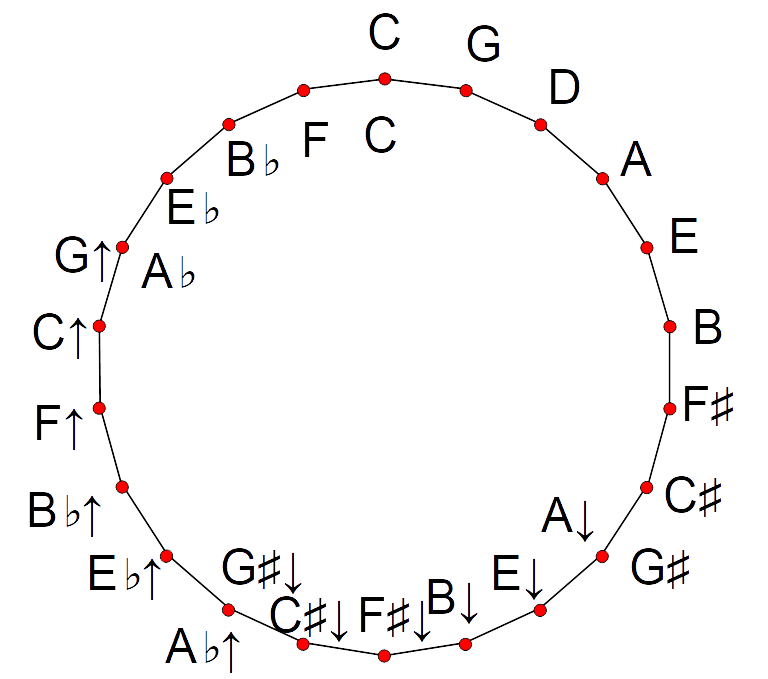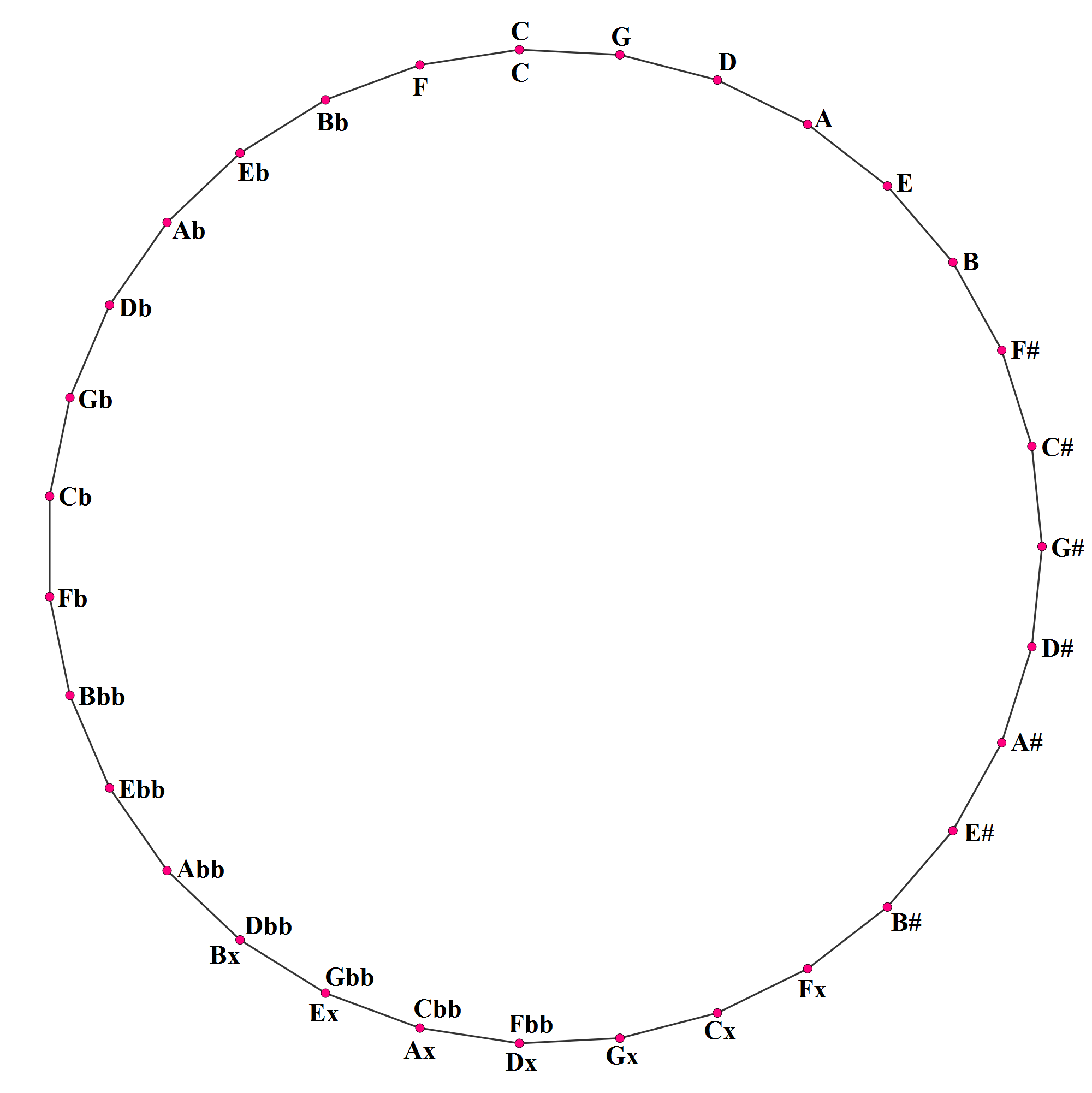|
Diminished Third
In classical music from Western culture, a diminished third () is the musical interval produced by narrowing a minor third by a chromatic semitone.Benward & Saker (2003). ''Music: In Theory and Practice, Vol. I'', p.54. . For instance, the interval from A to C is a minor third, three semitones wide, and both the intervals from A to C, and from A to C are diminished thirds, two semitones wide. Being diminished, it is considered a dissonant interval. In equal temperament a diminished third is enharmonic with the major second, both having a value of 200 cents. However, in meantone tunings with fifths flatter than the 700 cents of equal temperament, the diminished third is wider than the major second. In 19 equal temperament it is in fact enharmonically equivalent to an augmented second, both having a value of 252.6 cents. In 31 equal temperament it has a more typical value of 232.3 cents. In a twelve-note keyboard tuned in a meantone tuning from E to G, the dimininished third a ... [...More Info...] [...Related Items...] OR: [Wikipedia] [Google] [Baidu] |
Augmented Sixth
In classical music from Western culture, an augmented sixth () is an interval produced by widening a major sixth by a chromatic semitone.Benward & Saker (2003). ''Music: In Theory and Practice, Vol. I'', p.54. . Specific example of an A6 not given but general example of augmenting major intervals described. For instance, the interval from C to A is a major sixth, nine semitones wide, and both the intervals from C to A, and from C to A are augmented sixths, spanning ten semitones. Being augmented, it is considered a dissonant interval. Its inversion is the diminished third, and its enharmonic equivalent is the minor seventh. In septimal meantone temperament, it is specifically equivalent to the harmonic seventh (a just interval of 7:4). In the tuning system known as equal temperament the augmented sixth is equal to ten semitones and is a dissonant interval. The augmented sixth is relatively rare. Its most common occurrence is built on the lowered submediant of the prevailing k ... [...More Info...] [...Related Items...] OR: [Wikipedia] [Google] [Baidu] |
19 Equal Temperament
In music, 19 Tone Equal Temperament, called 19 TET, 19 EDO ("Equal Division of the Octave"), or 19 ET, is the tempered scale derived by dividing the octave into 19 equal steps (equal frequency ratios). Each step represents a frequency ratio of , or 63.16 cents (). The fact that traditional western music maps unambiguously onto this scale (unless it presupposes 12-EDO enharmonic equivalences) makes it easier to perform such music in this tuning than in many other tunings. 19 EDO is the tuning of the syntonic temperament in which the tempered perfect fifth is equal to 694.737 cents, as shown in Figure 1 (look for the label "19 TET"). On an isomorphic keyboard, the fingering of music composed in 19 EDO is precisely the same as it is in any other syntonic tuning (such as 12 EDO), so long as the notes are "spelled properly" – that is, with no assumption that the sharp below matches the flat immediately above it ( enharmo ... [...More Info...] [...Related Items...] OR: [Wikipedia] [Google] [Baidu] |
List Of Meantone Intervals
The following is a list of intervals of extended meantone temperament. These intervals constitute the standard vocabulary of intervals for the Western common practice era. Here 12-EDO refers to the size of the interval in 12 equal divisions of the octave temperament, which is the most common meantone temperament of the modern era, 19-EDO to 19 equal temperament, 31-EDO to 31 equal temperament, and 50-EDO to 50 equal temperament. Note that several of the intervals for 31-EDO and 50-EDO are absent from the table. In ''How Equal Temperament Ruined Harmony (and Why You Should Care)'', pp. 91–92, Ross W. Duffin states: "specifying that the major semitone should be 3/2 the minor semitone 3:2 ratiocreates a 31-note division of the octave, which, in turn, closely corresponds to extended-quarter-comma meantone... the 5:4 ratio hoseextended-sixth-comma meantone corresponds to the 55-division... extended-fifth-comma meantone orresponds tothe 43-division of the octave n which ther ... [...More Info...] [...Related Items...] OR: [Wikipedia] [Google] [Baidu] |
Augmented Sixth Chord
In music theory, an augmented sixth chord contains the interval of an augmented sixth, usually above its bass tone. This chord has its origins in the Renaissance, was further developed in the Baroque, and became a distinctive part of the musical style of the Classical and Romantic periods. Conventionally used with a predominant function ( resolving to the dominant), the three most common types of augmented sixth chords are usually called the ''Italian sixth'', the ''French sixth'', and the ''German sixth''. Augmented sixth interval The augmented sixth interval is typically between the sixth degree of the minor scale, , and the raised fourth degree, . With standard voice leading, the chord is followed directly or indirectly by some form of the dominant chord, in which both and have resolved to the fifth scale degree, . This tendency to resolve outwards to is why the interval is spelled as an augmented sixth, rather than enharmonically as a minor seventh ( and ). Alt ... [...More Info...] [...Related Items...] OR: [Wikipedia] [Google] [Baidu] |
Common Practice
In European art music, the common-practice period is the era of the tonal system. Most of its features persisted from the mid-Baroque period through the Classical and Romantic periods, roughly from 1650 to 1900. There was much stylistic evolution during these centuries, with patterns and conventions flourishing and then declining, such as the sonata form. The most prominent, unifying feature throughout the period is a harmonic language to which music theorists can today apply Roman numeral chord analysis. Technical features Harmony The harmonic language of this period is known as "common-practice tonality", or sometimes the "tonal system" (though whether tonality implies common-practice idioms is a question of debate). Common-practice tonality represents a union between harmonic function and counterpoint. In other words, individual melodic lines, when taken together, express harmonic unity and goal-oriented progression. In tonal music, each tone in the diatonic scale function ... [...More Info...] [...Related Items...] OR: [Wikipedia] [Google] [Baidu] |
Complement (music)
In music theory, ''complement'' refers to either traditional interval complementation, or the aggregate complementation of twelve-tone and serialism. In interval complementation a complement is the interval which, when added to the original interval, spans an octave in total. For example, a major 3rd is the complement of a minor 6th. The complement of any interval is also known as its ''inverse'' or ''inversion''. Note that the octave and the unison are each other's complements and that the tritone is its own complement (though the latter is "re-spelt" as either an augmented fourth or a diminished fifth, depending on the context). In the aggregate complementation of twelve-tone music and serialism the complement of one set of notes from the chromatic scale contains all the ''other'' notes of the scale. For example, A-B-C-D-E-F-G is ''complemented'' by B-C-E-F-A. Note that ''musical set theory'' broadens the definition of both senses somewhat. Interval complementation Rule of ... [...More Info...] [...Related Items...] OR: [Wikipedia] [Google] [Baidu] |
Quarter-comma Meantone
Quarter-comma meantone, or -comma meantone, was the most common meantone temperament in the sixteenth and seventeenth centuries, and was sometimes used later. In this system the perfect fifth is flattened by one quarter of a syntonic comma (81:80), with respect to its just intonation used in Pythagorean tuning (frequency ratio 3:2); the result is × () = ≈ 1.49535, or a fifth of 696.578 cents. (The 12th power of that value is 125, whereas 7 octaves is 128, and so falls 41.059 cents short.) This fifth is then iterated to generate the diatonic scale and other notes of the temperament. The purpose is to obtain justly intoned major thirds (with a frequency ratio equal to 5:4). It was described by Pietro Aron in his ''Toscanello de la Musica'' of 1523, by saying the major thirds should be tuned to be "sonorous and just, as united as possible." Later theorists Gioseffo Zarlino and Francisco de Salinas described the tuning with mathematical exactitude. Construction In a meantone t ... [...More Info...] [...Related Items...] OR: [Wikipedia] [Google] [Baidu] |
Septimal Major Second
In music, the septimal whole tone, septimal major second, or supermajor second is the musical interval exactly or approximately equal to an 8/7 ratio of frequencies.Andrew Horner, Lydia Ayres (2002). ''Cooking with Csound: Woodwind and Brass Recipes'', p.131. . "Super-Major Second". It is about 231 cents wide in just intonation.Leta E. Miller, Fredric Lieberman (2006). ''Lou Harrison'', p.72. . 24 equal temperament does not match this interval particularly well, its nearest representation being at 250 cents, approximately 19 cents sharp. The septimal whole tone may be derived from the harmonic series as the interval between the seventh and eighth harmonics and the term ''septimal'' refers to the fact that it utilizes the seventh harmonic. It can also be thought of as the octave inversion of the 7/4 interval, the harmonic seventh. No close approximation to this interval exists in the standard 12 equal temperament used in most modern western music. The very simple 5 equal ... [...More Info...] [...Related Items...] OR: [Wikipedia] [Google] [Baidu] |
Septimal Meantone Temperament
In music, septimal meantone temperament, also called ''standard septimal meantone'' or simply ''septimal meantone'', refers to the tempering of 7-limit musical intervals by a meantone temperament tuning in the range from fifths flattened by the amount of fifths for 12 equal temperament to those as flat as 19 equal temperament, with 31 equal temperament being a more or less optimal tuning for both the 5- and 7-limits. Meantone temperament represents a frequency ratio of approximately 5 by means of four fifths, so that the major third, for instance C–E, is obtained from two tones in succession. Septimal meantone represents the frequency ratio of 56 (7 × 23) by ten fifths, so that the interval 7:4 is reached by five successive tones. Hence C–A, not C–B, represents a 7:4 interval in septimal meantone. :*A ≈ B *C — G — D — A — E — B — F — C — G — D — A *C — ≈G — ≈D — ≈A — ≈E — ≈B — ≈F — ≈C — ≈G — ≈D — =B The ... [...More Info...] [...Related Items...] OR: [Wikipedia] [Google] [Baidu] |
22 Equal Temperament
In music, 22 equal temperament, called 22-TET, 22- EDO, or 22-ET, is the tempered scale derived by dividing the octave into 22 equal steps (equal frequency ratios). Each step represents a frequency ratio of , or 54.55 cents (). When composing with 22-ET, one needs to take into account a variety of considerations. Considering the 5-limit, there is a difference between 3 fifths and the sum of 1 fourth + 1 major third. It means that, starting from C, there are two A's - one 16 steps and one 17 steps away. There is also a difference between a major tone and a minor tone. In C major, the second note (D) will be 4 steps away. However, in A minor, where A is 6 steps below C, the fourth note (D) will be 9 steps above A, so 3 steps above C. So when switching from C major to A minor, one need to slightly change the note D. These discrepancies arise because, unlike 12-ET, 22-ET does not temper out the syntonic comma of 81/80, and in fact exaggerates its size by mapping it to one step. Ext ... [...More Info...] [...Related Items...] OR: [Wikipedia] [Google] [Baidu] |
17 Equal Temperament
In music, 17 tone equal temperament is the tempered scale derived by dividing the octave into 17 equal steps (equal frequency ratios). Each step represents a frequency ratio of , or 70.6 cents. 17-ET is the tuning of the regular diatonic tuning in which the tempered perfect fifth is equal to 705.88 cents, as shown in Figure 1 (look for the label "17-TET"). History and use Alexander J. Ellis refers to a tuning of seventeen tones based on perfect fourths and fifths as the Arabic scale. Ellis, Alexander J. (1863). "On the Temperament of Musical Instruments with Fixed Tones", ''Proceedings of the Royal Society of London'', vol. 13. (1863–1864), pp. 404–422. In the thirteenth century, Middle-Eastern musician Safi al-Din Urmawi developed a theoretical system of seventeen tones to describe Arabic and Persian music, although the tones were not equally spaced. This 17-tone system remained the primary theoretical system until the development of the quarter tone scale A quarter ... [...More Info...] [...Related Items...] OR: [Wikipedia] [Google] [Baidu] |
31 Equal Temperament
In music, 31 equal temperament, 31-ET, which can also be abbreviated 31-TET (31 tone ET) or 31- EDO (equal division of the octave), also known as tricesimoprimal, is the tempered scale derived by dividing the octave into 31 equal-sized steps (equal frequency ratios). Each step represents a frequency ratio of , or 38.71 cents (). 31-ET is a very good approximation of quarter-comma meantone temperament. More generally, it is a regular diatonic tuning in which the tempered perfect fifth is equal to 696.77 cents, as shown in Figure 1. On an isomorphic keyboard, the fingering of music composed in 31-ET is precisely the same as it is in any other syntonic tuning (such as 12-ET), so long as the notes are spelled properly — that is, with no assumption of enharmonicity. History and use Division of the octave into 31 steps arose naturally out of Renaissance music theory; the lesser diesis — the ratio of an octave to three major thirds, 128:125 or 41.06 cents — was approximat ... [...More Info...] [...Related Items...] OR: [Wikipedia] [Google] [Baidu] |







